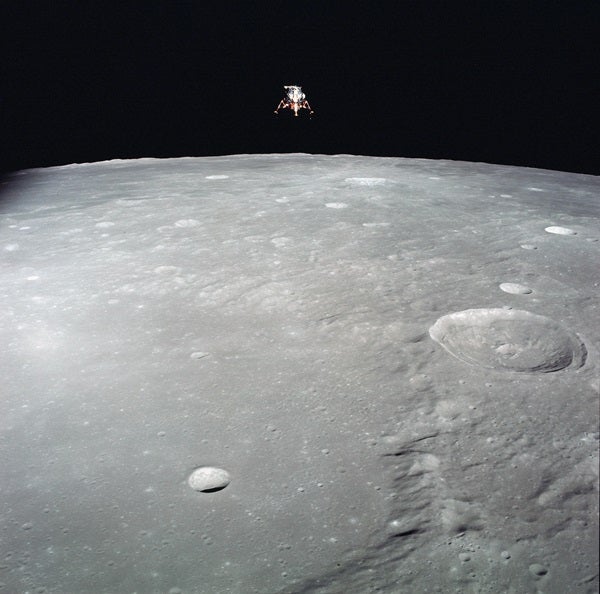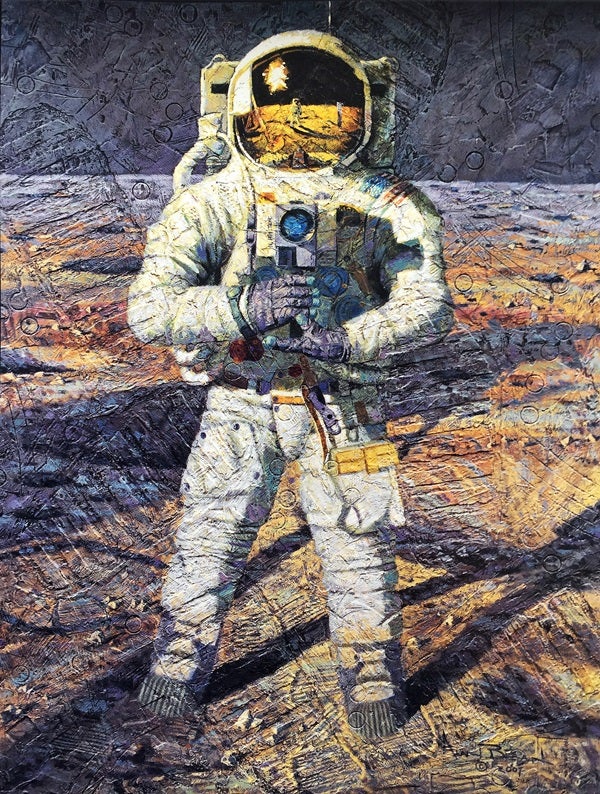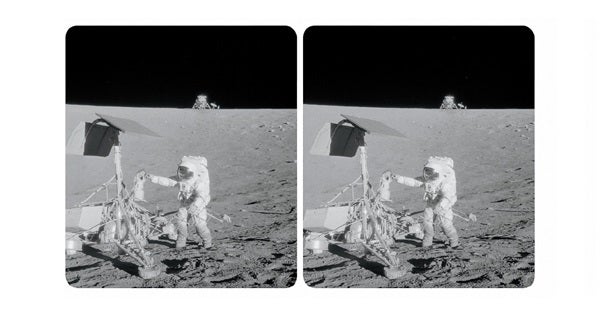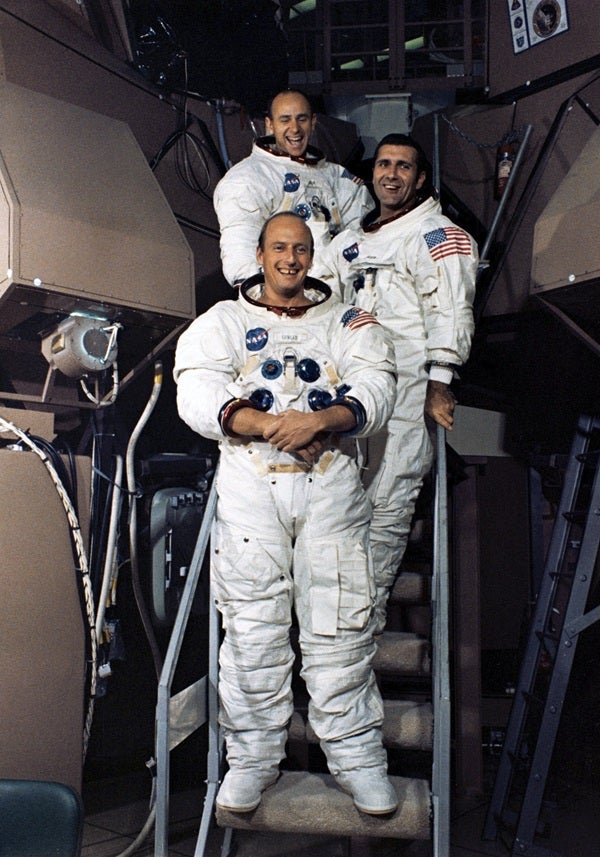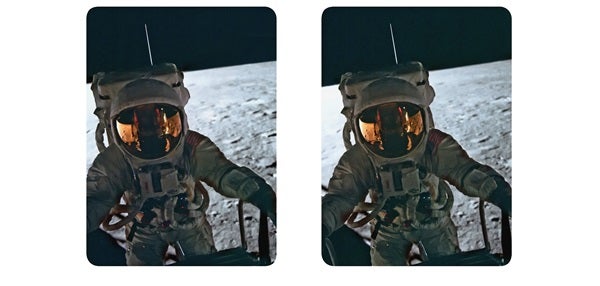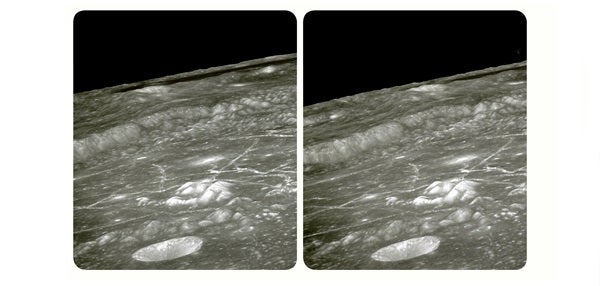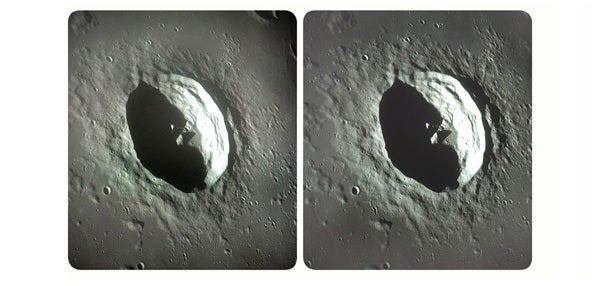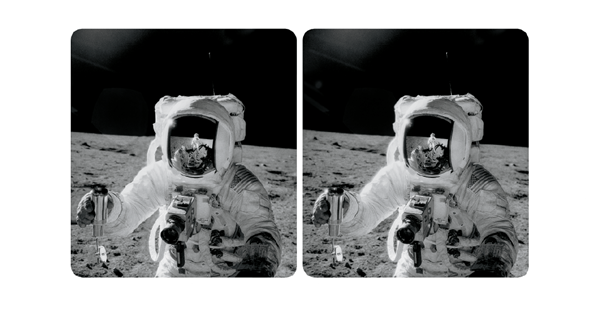Four months after the triumphant mission of Neil Armstrong, Buzz Aldrin, and Michael Collins, NASA was ready for its first follow-up act. Apollo 12 began where the previous mission had left off, with a longer and larger array of activities on the lunar surface. The sixth manned flight of the Apollo program targeted an area known as Oceanus Procellarum— the Ocean of Storms — a mare near the western edge of the Moon’s nearside. This largest of all lunar maria covers a vast 1.5 million square miles (4 million square kilometers) and stretches roughly 1,600 miles (2,600 km) from end to end.
Meet the crew
The Apollo 12 crew drew from the large pool of available astronauts and comprised Pete Conrad as commander, Dick Gordon as command module pilot, and Alan Bean as lunar module pilot. The group brought a mixed array of experience. Conrad, age 39, was a native of Philadelphia, a naval officer, and a test pilot who had joined NASA’s second astronaut group. He was a veteran of two previous missions: Gemini V and Gemini XI. The first astronaut from his group to fly a Gemini mission, he became the holder of a space endurance record, along with Gordon Cooper, when Gemini V spent just under eight days in orbit. During Gemini XI, Conrad, along with Dick Gordon, had docked with an Agena Target Vehicle soon after reaching low Earth orbit. The mission gained notoriety for testing the maneuver, which simulated the kind of docking required to connect the Apollo command module (CM) and lunar module (LM). Gemini XI also achieved the highest Earth orbit ever: an apogee, or most distant point in the orbit, of 851 miles (1,369 km).
Dick Gordon was also a spaceflight veteran. Seattle-born and 40 years old, Gordon was a naval officer and aviator, test pilot, and chemist. One of NASA’s third astronaut group, Gordon cut his teeth as backup pilot for the Gemini VIII mission before being assigned to Gemini XI with Conrad. Gordon and Conrad were selected to fly on the Gemini mission together, as well as on Apollo 12, in part because they were close friends and had even been roommates on the aircraft carrier USS Ranger during their naval careers in the 1950s. On the Gemini XI mission, Gordon conducted two spacewalks, during which he secured himself by attaching a tether to the Agena vehicle while it was docked with the Gemini capsule.
Apollo 12 marked the first flight into space for LM pilot Alan Bean, age 37. Born in Wheeler, Texas, Bean was a naval aviator, aeronautical engineer, and test pilot. Like Gordon, he was a member of NASA astronaut group three. Although Bean was selected as backup commander for Gemini X, he grew frustrated with his exclusion from the early Apollo flights when, despite Conrad’s request for Bean, NASA placed Bean’s classmate Clifton Williams as a backup crewmember on Apollo 9. (By protocol, this position was also targeted to fly as a prime crewmember on Apollo 12.) Bean dedicated himself to astronaut training procedures; when Williams was killed in an air crash, Conrad again requested Bean. This time, NASA agreed.
Long after Apollo 12, Bean’s paintings of Apollo 12 and other missions became highly celebrated. Describing how his astronaut career produced scenes that few had seen, Bean said his experiences gave him his special drive to share this vision with others. His paintings are now regarded as treasures associated with NASA and the space program.
An uneasy start
The launch of Apollo 12 was scheduled for November 14, 1969, pushing close to the end of the ’60s and the self-imposed deadline for reaching the Moon stated in John Kennedy’s original motivating speech. By now, culture had swung upside down. The United States was looking for a way out of the Vietnam War, hippie optimism was fading in the wake of the Manson Family’s summer murders in Los Angeles, and summertime rock festivals like Woodstock had enjoyed their last gasp.
But the spirit of NASA’s quest for the Moon continued on apace. Launch day was not optimal — a rainstorm hovered over the Kennedy Space Center, but it did not thwart the crew or the support staff. Conrad, Gordon, and Bean loaded into the CM and readied themselves for an on-time liftoff. The spacecraft components were given more “traditional” call signs than previous missions: The CM was designated Yankee Clipper and the LM as Intrepid.
President Richard Nixon was in Florida to watch the launch in person. At liftoff, the mighty Saturn V lurched skyward. Just 36 seconds into the flight, a bolt of lightning shot down through the rocket into the plume of ionized gas trailing below and to the ground.
The rocket itself had triggered the discharge, and that lightning bolt was a problem. Inside the service module, three sensors detected the bolt as an overload, although it actually wasn’t. This detection, however, automatically knocked three fuel cells offline and shut down much of the instrumentation inside the CM. And the trouble wasn’t over. Just 16 seconds later, the rising rocket was hit by another lightning strike, which knocked out the “8-ball” attitude gauge inside the CM. Communications became a problem. The stream of telemetry heading to Mission Control in Houston, carrying important data back and forth to the spacecraft, turned into unintelligible garble.
Despite these events, the spacecraft continued on the proper course. The lightning strikes had not adversely altered the Saturn V Instrument Unit, which continued operating properly and kept the craft on target. Inside the CM, however, the crew was unsettled. The loss of the fuel cells meant the CM was running on battery power, which activated nearly every alarm and warning light on the spacecraft’s control panel.
On the ground, flight controller John Aaron recognized the pattern of malfunctions from an earlier test. He suggested to his colleagues in Mission Control that the astronauts switch the spacecraft’s Signal Conditioning Electronics (SCE) unit, which allowed signals from the spacecraft to read properly on displays in Mission Control, to auxiliary power. Such a move, Aaron knew, would allow the SCE to continue functioning, restoring instrument readouts so the affected fuel cells could be restarted.
None of the others, including Conrad, Flight Director Gerry Griffin, and Capsule Communicator Gerald Carr, recognized the potential solution. And when the command was related to the astronauts, only Bean, the one crewmember on his first flight, remembered the procedure from a simulated failure in a training mission. Bean switched the fuel cells back online and the spacecraft began to right itself. The telemetry came back, communications were restored, alarms silenced, and data systems were returned. The quick actions of Aaron and Bean saved the mission from a potential abort just a short time into the flight. The spacecraft entered Earth orbit and the astronauts carefully checked the systems before initiating a trans-lunar injection, firing the Saturn’s third-stage rockets to carry them toward the Moon.
Those careful spacecraft checks had assuaged some serious fears. Others, however, remained. Controllers worried that the lightning strikes could have compromised the parachute package, firing it early and thereby leaving no way for the astronauts to safely get home. In this scenario, the CM would plummet into the ocean in an uncontrolled, high-velocity dive, killing the crew. But the controllers felt this was an unlikely possibility — as well as one that had no solution — and did not tell the crew about it.
A malfunction also affected the Saturn rocket’s third stage, the S-IVB, later in the mission. Instead of being sent into a solar orbit by the Moon’s gravitational field after separating from the LM, Apollo 12’s S-IVB flew past the Moon at too high an altitude, caused by an error in the guidance system. After passing the Moon, it stayed briefly in a semi-stable high Earth orbit, but escaped to orbit the Sun two years later. The rocket stage was recaptured into Earth orbit in 2002 and spotted by an amateur astronomer, who first believed it was an asteroid. It has since been identified as an artifact of the Apollo 12 mission, some 33 years after the fact.
Parking the LM
Following their four-day cruise to the Moon, the crew of Apollo 12 separated in anticipation of their approach of the lunar surface. Gordon remained in orbit inside the CM, while Conrad and Bean entered the LM, undocked from the CM, and descended toward the target area in Oceanus Procellarum.
Apollo 12’s approach and landing was in stark contrast to that of Apollo 11. In the previous mission, Armstrong had to use manual controls to avoid a boulder-strewn area and bring the LM down at the correct point before depleting the available fuel. But Apollo 12’s descent was an exercise in precision targeting. The area was already one of interest: This region had been visited by several unmanned spacecraft, including NASA’s Surveyor 3 and Ranger 7, as well as the Soviet Luna 5. The site would later be called Statio Cognitum on lunar maps, in keeping with the International Astronomical Union’s naming of the small region as Mare Cognitum, meaning “Known Sea,” in 1964.
Conrad, who always had a good sense of humor, had named the intended landing site “Pete’s Parking Lot.” The LM’s descent was automated, with Conrad taking over only for manual adjustments near the final portion of the landing. However, he became somewhat concerned with the roughness of the surface during final descent and adjusted the LM’s trajectory to fall short of the intended target.
On November 19, 1969, Intrepid landed 600 feet (180 meters) from Surveyor 3. The spot had been chosen for its proximity to the probe, but far enough away that lunar regolith blasted upward by the descent engine would not damage it. The older spacecraft had landed two years earlier as one of several U.S. robotic craft sent to the Moon during the developmental phase of the Apollo program. It came down in a small crater and, because its engines failed to cut off at the intended elevation of 14 feet (4 m), the craft bounced twice, rising up again some 35 feet (11 m) before settling in its final location. The mission’s science activities lasted for two days and 17 hours, during which the craft dug several small trenches, scooped up soil, and sent close-up pictures of the lunar soil back to Earth with the TV camera mounted onboard.
Apollo 12 landed so close to Surveyor 3 that the touchdown did somewhat sandblast the probe with lunar regolith. The LM was also close enough that the crew could later walk over to the older spacecraft. Apollo 12 thus became the first mission to visit, with human explorers, an older probe. The sandblasting had made over the surface of Surveyor 3 — although the astronauts noted that most of the craft had a tan hue from the lunar dust, the sandblasted portions had exposed its pure white, original finish.
Lunar activities
After their November 19 touchdown, Conrad and Bean rested and prepared for the mission’s science activities. In contrast with Apollo 11, the pair spent about a day and a half on the lunar surface, conducting two extravehicular activities that totaled just over 7 hours 45 minutes spent outside the LM.
The first moonwalk started about five hours after the LM touched down and lasted just four minutes shy of four hours. Conrad descended the LM’s ladder first, and thus became the third human to walk on the Moon. Again he demonstrated his sense of humor, paying homage to Armstrong by blurting out, “Whoopie! Man, that may have been a small one for Neil, but that’s a long one for me!” The joke in part referenced Conrad’s somewhat short stature, and had actually been orchestrated: Conrad had made a $500 bet with a reporter that he would say that line, after she had asked him about Armstrong’s famous declaration.
Bean followed, and the astronauts accomplished a great deal scientifically during their two moonwalks. The second took place 11 hours after the end of the first and lasted about 3 hours 50 minutes. During this trip, Conrad and Bean walked over to the Surveyor 3 craft and disassembled pieces of the spacecraft, removing 22 pounds (10 kilograms) of material to take back to Earth, including the probe’s camera. After the camera was analyzed back on Earth, reports circulated that it contained live bacteria called Streptococcus mitis. Finding this common bacterium puzzled NASA researchers. At first the agency claimed that the camera had not been properly sterilized before being sent on the Surveyor 3 mission, saying that the bacteria had survived a trip from Earth to the Moon and back again. However, NASA later reversed its position, changing the explanation to contamination by workers who examined the camera after its return to Earth: The camera came back in a porous bag, workers had their bare arms exposed as they examined the camera, and other sloppy procedures had been employed.
The experiments performed by Conrad and Bean set the stage for more complex science on the remaining Apollo missions. They set up the first Apollo Lunar Surface Experiments Package, a collection of sensors that would relay long-term data about the Moon back to Earth. The astronauts measured the lunar magnetic field, collected seismic data, and observed the solar wind. Conrad and Bean also carried the first color TV camera onto the Moon, attempting to increase the quality of television transmission back to Earth substantially. But when Bean carted the camera to a position near the LM and began to set it up, he accidentally pointed the lens toward the Sun, destroying the camera’s primary tube and thus ending the TV coverage of the mission right away.
As with all lunar missions, the astronauts collected a substantial number of Moon rocks. Analysis of the first returned sample indicated the rocks were far more similar to Earth rocks than had been previously believed. The similarities remained a mystery for a time, and ultimately led to a stunning hypothesis about the origin of the Moon. (See “The Moon’s violent origin,” page 44.) The astronauts also took large numbers of photographs, although Bean accidentally left some behind when he departed, so exposed rolls of Apollo 12 film still sit on the Moon’s surface today.
Successful return
After their second moonwalk, Conrad and Bean rested in the LM. On November 20, they ignited the ascent engine, which pushed them upward to dock with Gordon in the CM once again. For the second time, humans left the Moon behind. The LM’s ascent stage dropped away after docking, where the seismometers left on the lunar surface recorded vibrations from its impact that lasted for more than an hour. The trio of astronauts spent a day taking pictures of the Moon’s surface from orbit before heading for home.
On the way back, Apollo 12 marked another first when the crew witnessed an eclipse of the Sun by Earth from their spacecraft windows. They splashed down in the Pacific Ocean on November 24, east of American Samoa. During splashdown, one of the astronauts’ film cameras fell, striking Bean in the head — knocking him briefly unconscious and causing a mild concussion.
The crew was recovered by the USS Hornet, returned to the United States as heroes, and the successful mission made the statement that the Apollo program, and repeated trips to the Moon, were here to stay.

